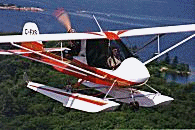Challenger
II
Performance |
Long
Wing |
Clip
Wing |
 |
 |
 |
 |
 |
Typical Challenger II 503 Deluxe Package
on wheels
with 170 lb occupants in average sea level conditions.
|
 |
 |
 |
 |
 |
 |
 |
 |
 |
 |
|
Vne
|
This never exceed speed is very high for ultralight aircraft. |
100 mph |
120 mph |
|
Top Level Speed
|
With a top speed of 96 mph and a stall of 24 mph, the
long wing Challenger delivers an impressive high end without sacrificing
friendly, low speed approaches and handling. A 4 to 1 speed range is unusually
wide, few general aviation aircraft can exceed 2.8 to 1. |
96 mph |
100 mph |
|
Cruise
Speed
|
Low drag tandem seating, an engine tucked out of the
slipstream, and attention to streamlining result in an unusually high cruise
speed. Few if any designs can deliver this speed with such an economical
engine. |
85 mph
(5800 rpm)
35 mph
(4000 rpm) |
90 mph
(5800 rpm)
40 mph
(4000 rpm) |
|
Stall
Speed
Flaperons
Extended
|
The Challenger's large wing area and low weight result
in a very low speed and exceptionally gentle stall. This is key to short
field performance and is an important safety feature. It also contributes
to the long wing Challenger's unequalled soaring capability. |
24/28
mph
(solo/dual) |
32/37
mph
(solo/dual) |
 |
 |
 |
 |
 |
 |
 |
 |
 |
 |
 |
 |
|
Rate
of
Climb
|
The rate of climb is very strong by any standard. This
together with a climb speed in the low 40s means the plane goes forward
quite slowly while going up quite quickly, resulting in a helicopter-like
angle of climb! Getting out of short fields (and lakes) is a snap. |
1,100 /
750 fpm
(solo/dual) |
1,000 /
650 fpm
(solo/dual) |
|
Service
Ceiling
|
Most people think of ultralights as only flying low,
near the ground. The Challenger goes high too, up into oxygen country.
The heated cabin takes the nip out of the thin air found at these exalted
altitudes. |
14,000 /
12,500 ft
(solo/dual) |
14,000 /
12,500 ft
(solo/dual) |
 |
 |
 |
 |
 |
 |
 |
 |
 |
 |
 |
 |
|
Glide
Ratio
|
The glide ratio of Challengers is excellent by powered
aircraft standards. From 5000 feet you can glide 11 miles with the engine
off! Key to the unique soaring capability of the long wing are the low
drag tandem seating and low wing loading, which result in a low sink rate,
plus the low stall speed, which permits very small diameter turns in the
thermal's core. |
11 to 1 |
9 to 1 |
|
Minimum
Sink
|
Engine off, the long wing Challenger drifts down at an
unusually gentle rate, taking a full quarter hour to reach the ground from
5000 feet. Apart from aiding soaring, this low sink rate has obvious safety
benefits. The clip wing sinks faster than the long
wing but is still very gentle by General Aviation standards. |
350/450
fpm
(solo/dual) |
500/600
fpm
(solo/dual) |
 |
 |
 |
 |
 |
 |
 |
 |
 |
 |
 |
 |
|
Takeoff
& Landing
|
The large wing and light weight together with the high
power-to-weight ratio give great STOL performance. |
75-200
ft |
125-250
ft |
|
Maximum
Crosswind
|
The crosswind capability of the Challenger actually equals
or exceeds that of many General Aviation aircraft. As an example, the Cessna
172 has a crosswind capability of 17 mph. Puddlejumper amphibious floats
have a steerable nose wheel which allows Challengers so equipped to retain
their crosswind capabilities. |
20 mph |
30 mph |
 |
 |
 |
 |
 |
 |
 |
 |
 |
 |
 |
 |
|
Fuel
Consumption
|
Few two-seat aircraft are as miserly on fuel. Challengers
can use auto gas (87 octane), avgas (100LL) or marina gas (87-89 octane),
which may be intermixed. Most owners prefer regular car gas to minimize
costs. |
2.0-4.5
USgph |
2.0-4.5
USgph |
|
Fuel
Economy
|
These figures assume no wind.
YMMV - Your Mileage May Vary - depending on how heavy you are on the gas.
|
21-25
mpg |
21-25
mpg |
|
Endurance
no reserve
(10 / 17 USgal)
|
Endurance depends of course on how fast you want to cruise
- low and slow for sightseeing or blistering along to get somewhere soon.
Our Canadian Challenger's standard fuel tank is 10 US gallons. An optional
tank holding 17 US gallons provides greater endurance. |
2.2-5.0
/
3.8-8.5
hrs |
2.2-5.0
/
3.8-8.5
hrs |
|
Range
no wind
no reserve
(10 / 17 USgal)
|
Range varies with the size of your fuel tank, how fast
you cruise, how much reserve you allocate for contingencies, and of course
the wind. Non-stop flights of over 300 miles have been made but it's actually
more fun to make intermediate pit stops and be greeted by groundlings as
if you're a movie star in a Ferrari! |
200
/
350
sm |
200
/
350
sm |
 |
 |
 |
 |
 |
 |
 |
 |

